Hyundai Accent: Brake System / Rear Drum Brake
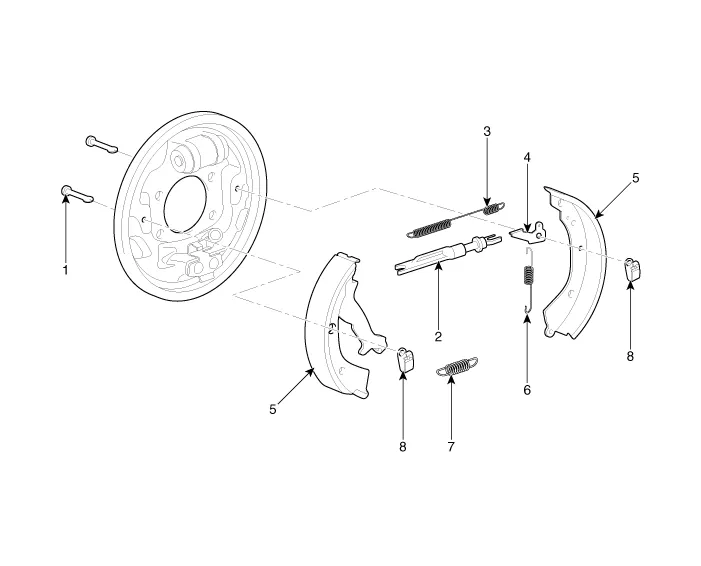
1. Shoe hold down pin
2. Shoe adjuster
3. Upper return spring
4. Adjusting lever
5. Shoe
6. Adjusting spring
7. Lower return spring
8. Shoe hold spring
1.Loosen the wheel nuts slightly. Raise the vehicle, and make sure it is securely supported.
2.Remove the rear wheel and tire (A).
Tightening torque :107.9 - 127.5 N.m (11.0 - 13.0 kgf.m, 79.6 - 94.0 lb-ft)
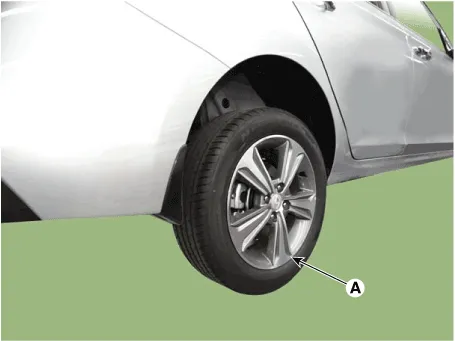

• Be careful not to damage the hub bolts when removing the rear wheel and tire.
3.Loosen the screw and then remove the drum.
Tightening torque :4.9 - 5.9 N.m (0.5 - 0.6 kgf.m, 3.6 - 4.3 lb-ft)
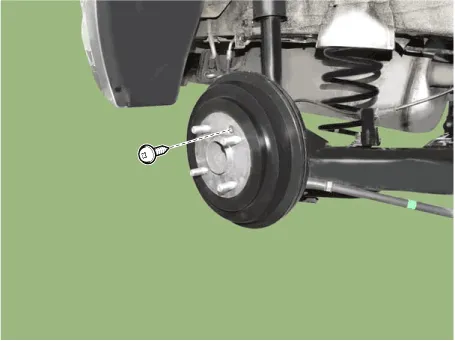
4.Remove the upper shoe return spring (A), lower shoe return spring (B), level pawl (C) and djuster assembly (D).
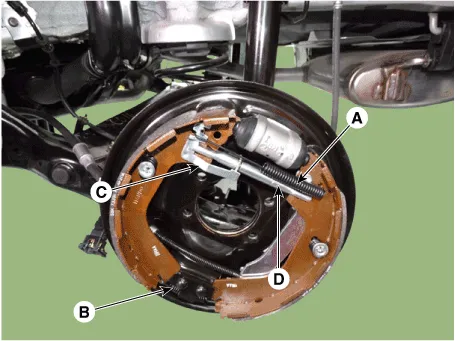
5.Remove the adjusting spring (A).
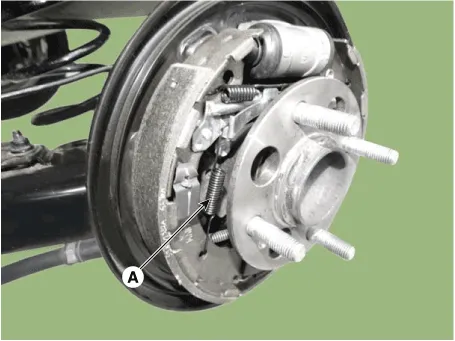
6.Remove the shoe hold assembly (A) and then remove the brake shoe.
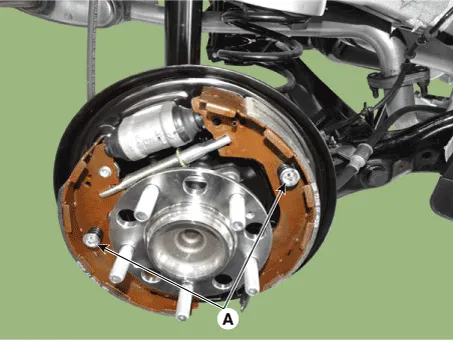
7.Disconnect the parking cable.
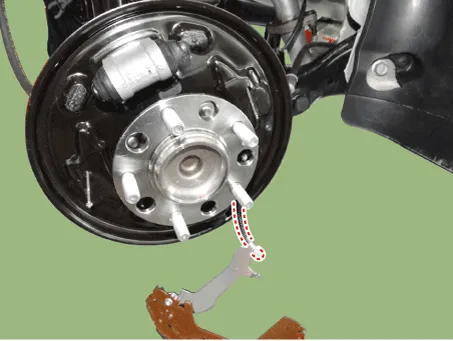
8.Disconnect the brake fluid tube flare nut (A).
Tightening torque :12.7 - 16.7 N.m (1.3 - 1.7 kgf.m, 9.4 - 12.3 lb-ft)
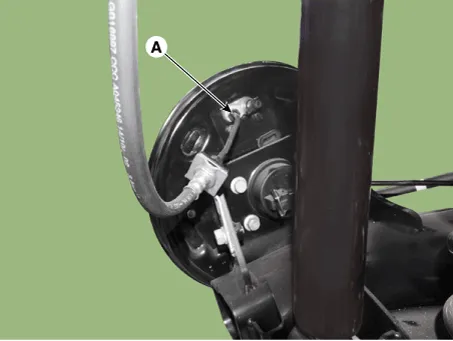
9.Loosen the mounting bolts (A) and then remove the wheel cylinder (B) from the backing plate (C).
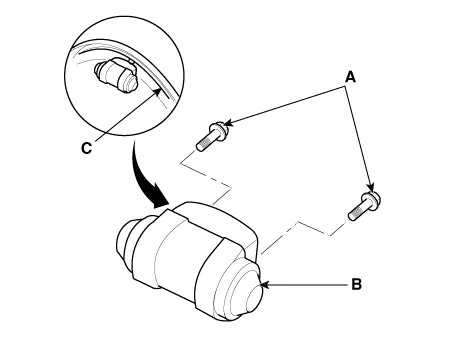
10.Install in the reverse order of removal.
11.After installation, bleed the brake system. (Refer to Brake System - "Brake System Bleeding")(Refer to Brake System - "ESP System Bleeding")(Refer to Brake System - "ABS System Bleeding")

• Frequent inhalation of brake pad dust, regardless of material composition, could be hazardous to your health.
• Avoid breathing dust particles.
• Never use an air hose or brush to clean brake assemblies.

• Contaminated brake linings or drums reduce stopping ability.
• Block the front wheels before jacking up the rear of the vehicle.
1.Raise the rear of the vehicle, and make sure it is securely supported.
2.Release the parking brake, and remove the rear brake drum.
3.Check the wheel cylinder (A) for leakage.
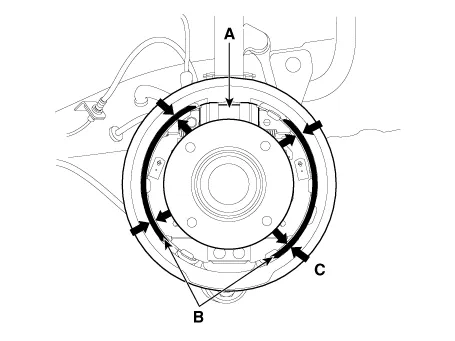
4.Check the brake linings (B) for cracking, glazing, wear, and contamination.
5.Measure the brake lining thickness (C).Measurement does not include brake shoe thickness.
Brake lining thicknessStandard : 4.5 mm (0.177 in)Service limit : 1.0 mm (0.039 in)
6.If the brake lining thickness is less than the service limit, replace the brake shoes as a set.
7.Check the bearings in the hub unit for smooth operation. If it requires servicing, replace it.
8.Measure the inside diameter of the brake drum with inside vernier calipers.
Drum inside diameterStandard : 205.3 mm (9.0 in)Service limit : 207.3 mm (9.08 in)Drum roundnessService limit : 0.06 mm (0.00236 in)
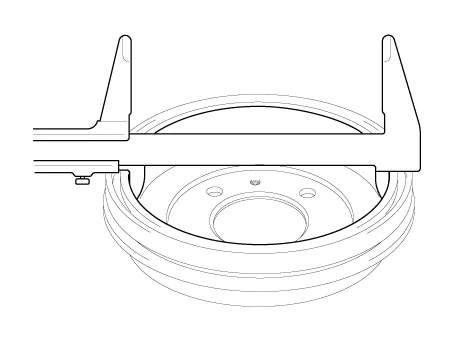
9.If the inside diameter of the brake drum is more than the service limit, replace the brake drum.
10.Check the brake drum for scoring, grooves, and cracks.
11.Inspect the brake lining and drum for proper contact.
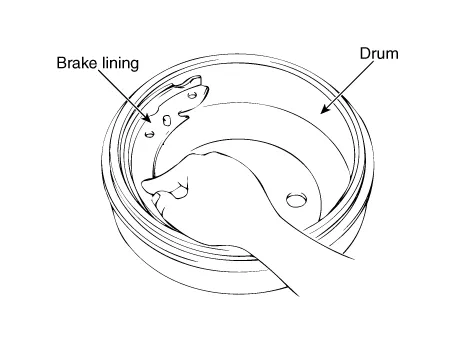
12.Inspect the wheel cylinder outside for excessive wear and damage.
13.Inspect the backing plate for wear or damage.
Other information:
Hyundai Accent (HC) (2017 - 2022) Service Manual: ETC (Electronic Throttle control) System
- Description The Electronic Throttle Control (ETC) System consists of a throttle body with an integrated control motor and throttle position sensor (TPS). Instead of the traditional throttle cable, an Accelerator Position Sensor (APS) is used to receive driver input. The ECM uses the APS signal to calculate the target throttle angle; the position of the throttle is then adjusted via ECM control of the ETC motor. - Specification Starter ItemSpecification Rated voltage12V, 0.9 kW The number of pinion teeth10 Performance[No-load, 11.5V]Ampere83.6 A Speed3,500 rpm - Components 1. Screw2. Front bracket3. Reducer assembly4. Lever5. Lever rest6. Magnet switch 7. Satellite gear8. Gasket sheet9. Armature assembly10. Yoke assembly11. Adjust washer12.
Categories
- Manuals Home
- Hyundai Accent Owners Manual
- Hyundai Accent Service Manual
- New on site
- Most important about car


